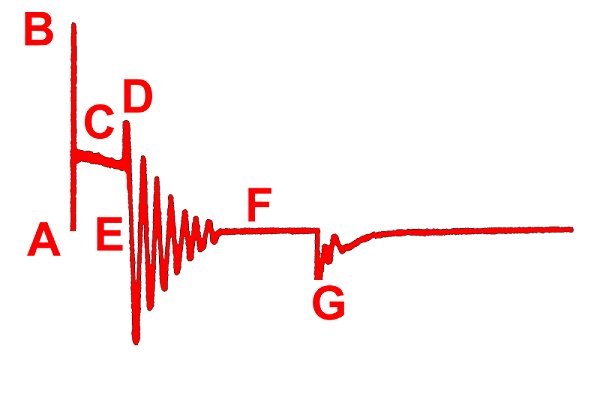
Above is an oscilloscope trace of an ignition event, taken as was once customary on its secondary (spark plug) side. The waveform's timeline is measured in milliseconds (thousandths of a second). At reference A the points have opened resulting in the ignition coil's primary winding powering down, making its magnetic field instantly collapse. This collapse mutually induces voltage in the coil's secondary winding, whose greater wire turns step up the voltage several hundred times, and the plug accumulates a head of bristling, aggressive voltage potential -- you can see this in the steep vertical line running from A to B. Raw voltage. In just a few thousandths of a second then, there's enough voltage to bridge the plug's gap, and spark happens, reference C.
This spark is really a wondrous thing to consider! The normally non-conducting air molecules inside the plug gap are super agitated by the electrical strain at the end of the plug. That 0.028" thick piece of of air literally becomes so bombarded, so overwhelmed, with Tesla coil like energy, it actually defies nature and becomes conductive. This is called "ionization", and it takes a lot of voltage to make this happen: around 5,000 volts under starting conditions. Now, let's focus on reference C again and consider four interesting things. First, notice that the spark's voltage is considerably lower than the peak voltage on the rise line. This shows it takes less voltage to feed the spark than it does to start it. Interesting. Second, also interesting is the spark's duration. Note that it lingers, on most ignitions several milliseconds. This is an important part of ignition, this duration, as it helps get combustion off to a good start. Third, did you catch that the spark's voltage decreases as the coil's energy is spent? That's electrical pressure dropping, like air rushing out of a punctured tire. And fourth, observe that the spark has a very sawtoothed look. It's jangly. This "electrical noise", as the engineers call it, actually produces radio waves that must be damped out by the resistor caps on the ends if the plug wires. That's why those caps are there.
Now look at reference D. Spark has stopped and look at what happens next. The voltage shoots upward again. Huh? Yes, with the plug no longer arcing, the ignition system suddenly doesn't have a load. So voltage surges. However, at point E we see that though the coil's voltage rises slightly, it isn't enough to ionize the plug gap again, so it immediately falls to zero. And even below zero, notice. But the coil isn't done yet. The secondary's voltage freefall cross-induces the primary, which reinduces the secondary, and the two windings go ping-pong, ping-pong for a considerable fraction of a second, until finally the coil is completely spent, noticeable at reference F. And even then the system isn't finished. One more thing is visible at point G, and that is that little blip on the zero line, a tiny backlash (negative, notice, because we're reading all of this on the secondary) when the points close in preparation for the next spark event. And just as with the coil, this blip also oscillates a little. After that, it's all over, that's the whole ignition event, completed in about a third of a second.
Ignition scope traces such as this one were used for diagnostics by mechanics for close to a hundred years. There's a lot there for those who know what they're looking at. For example, a scope might show all the engine's plugs in a row, and any that exhibit lower ionization lines than the others would indicate cylinders with lower compression. Or you might see a points closed blip whose first line is not the lowest, indicating dirty points. And there are many more of these tricks. Of course, scope traces are anachronistic now, what with engine scanners and other tools. But they nonetheless provide an interesting window into ignition function, and thus are useful for educational purposes.



